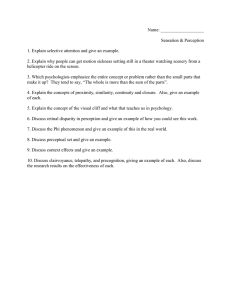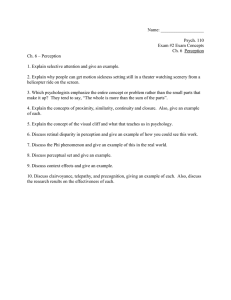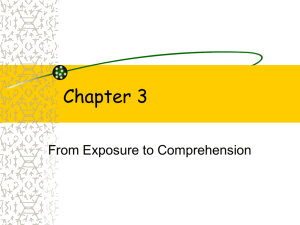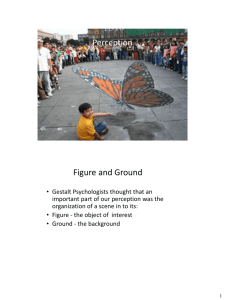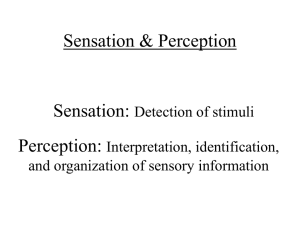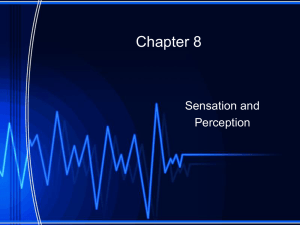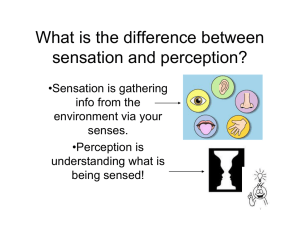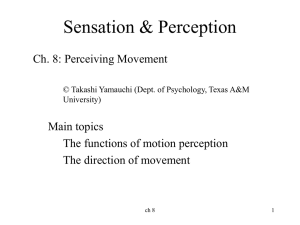Chapter 6 Practice Test
advertisement
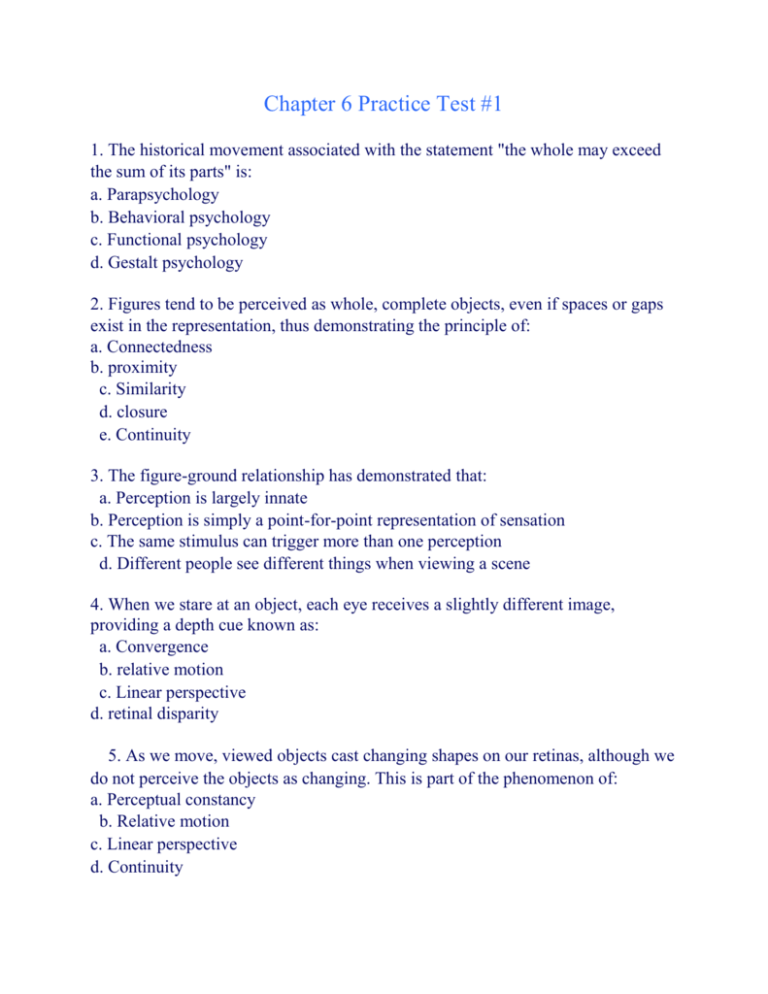
Chapter 6 Practice Test #1 1. The historical movement associated with the statement "the whole may exceed the sum of its parts" is: a. Parapsychology b. Behavioral psychology c. Functional psychology d. Gestalt psychology 2. Figures tend to be perceived as whole, complete objects, even if spaces or gaps exist in the representation, thus demonstrating the principle of: a. Connectedness b. proximity c. Similarity d. closure e. Continuity 3. The figure-ground relationship has demonstrated that: a. Perception is largely innate b. Perception is simply a point-for-point representation of sensation c. The same stimulus can trigger more than one perception d. Different people see different things when viewing a scene 4. When we stare at an object, each eye receives a slightly different image, providing a depth cue known as: a. Convergence b. relative motion c. Linear perspective d. retinal disparity 5. As we move, viewed objects cast changing shapes on our retinas, although we do not perceive the objects as changing. This is part of the phenomenon of: a. Perceptual constancy b. Relative motion c. Linear perspective d. Continuity 6. Which of the following illustrates the principle of visual capture? a. We tend to form first impressions of other people on the basis of appearance b. Because visual processing is automatic, we can pay attention to a visual image and any other sensation at the same time c. We cannot simultaneously attend to a visual image and another sensation d. When there is a conflict between visual information and that from another sense, vision tends to dominate 7. A person claiming to be able to read another's mind is claiming to have ESP ability of: a. Psychokinesis b. clairvoyance c. Precognition d. telepathy 8. Which philosopher maintained that knowledge comes from inborn ways of organizing our sensory experiences? a. Locke b. Walk c. Kant d. Neisser e. Gibson 9. Which of the following was not mentioned in the text as a criticism of parapsychology? a. ESP effects have not been consistently reproducible b. Parapsychology has suffered from a number of frauds and hoaxes c. The tendency of people to recall only events that confirm their expectations accounts for much of the belief in ESP d. There have been no laboratory-controlled studies of ESP 10. Which of the following depth cues creates the impression of a visual cliff? a. Interposition b. texture gradient c. Relative height d. Linear perspective e. relative clarity 11. Kittens reared seeing only horizontal lines: a. Later had difficulty perceiving both horizontal and vertical lines b. Later had difficulty perceiving vertical lines, but eventually regained normal sensitivity c. Later had difficulty perceiving vertical lines, and never regained normal sensitivity d. Showed no impairment in perception, indicating that neural feature detectors develop even in the absence of normal sensory experiences 12. Adults who are born blind but later have their vision restored: a. Are almost immediately able to recognize familiar objects b. Typically fail to recognize familiar objects c. Are unable to follow moving objects with their interpretation d. Have excellent eye-hand coordination 13. _____________ processing refers to how the physical characteristics of stimuli influence their interpretation a. top-down b. parapsychological c. bottom-up d. human factors 14. Which of the following is not a monocular depth cue? a. Texture gradient b. interposition c. Relative height d. light and shadow e. Retinal disparity 15. The moon illusion occurs in part because distance cues at the horizon make the moon seem: a. Farther away and therefore larger b. Closer and therefore larger c. Farther and therefore smaller d. Closer and therefore smaller 16. Figure is to ground as ________ is to _________. a. Night; day b. Top; bottom c. Cloud; sky d. Sensation; perception 17. The study of perception is primarily concerned with how we: a. Detect sights, sounds, and other stimuli b. Sense environmental stimuli c. Develop sensitivity to illusions d. Interpret sensory stimuli 18. Which of the following influences perception a. Biological maturation b. The context in which stimuli are perceived c. Expectations d. All of the above 19. Jack claims that he often has dreams that predict future events. He claims to have the power of: a. Telepathy b. precognition c. Clairvoyance d. psycokinesis 20. Using the ganzfeld procedure to investigate telepathy, researchers have found that: a. When external distractions are reduced, both the "sender" and the "receiver" become much more accurate in demonstrating ESP. b. Only "senders" become much more accurate c. Only "receivers" become much more accurate d. Over many studies, none of the above occur Answers: 1. D 2. D 3. C 4. D 5. A 6. D 7. D 8. C 9. D 10. B 11. C 12. B 13. C 14. E 15. A 16. C 17. D 18. D 19. B 20. A
